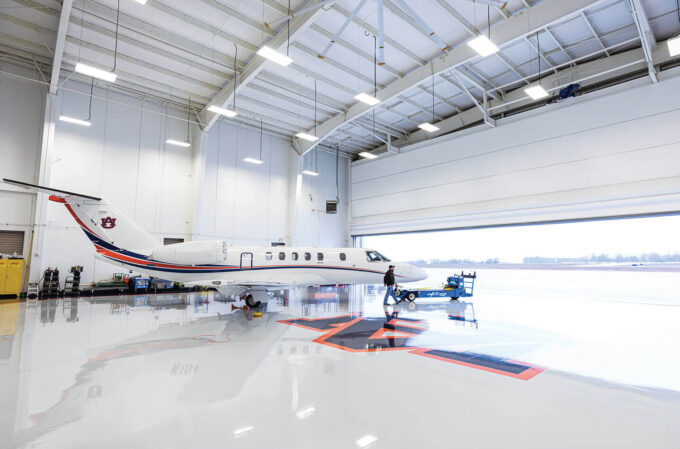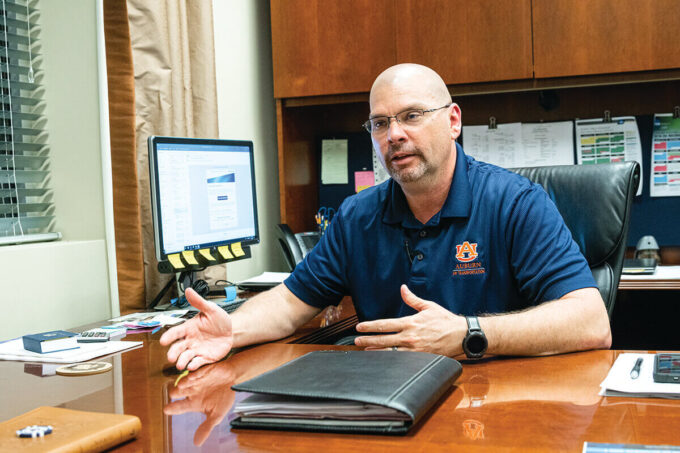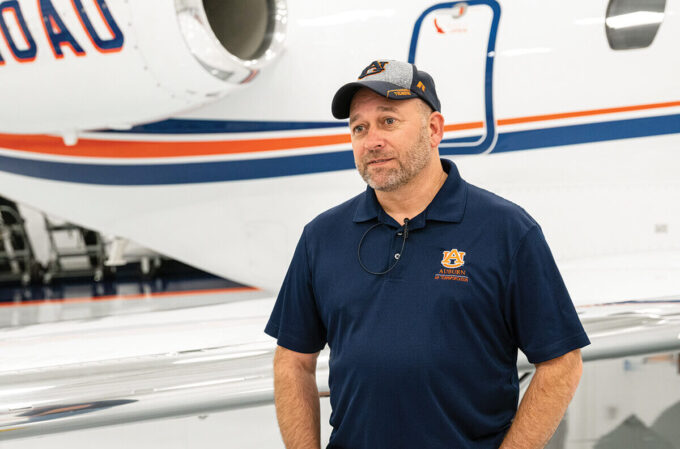Perhaps it shouldn’t be surprising that the secret of a collegiate flight operation’s success for more than five decades has been learning. Education, training, mentorship and professional development have helped Auburn University Air Transportation earn a 50-year NBAA Flying Safety Award and the strong support of institutional leadership.
“At an academic institution, it’s important to be able to collaborate with peers. Having the use of aviation allows our faculty to travel to other universities, symposia and wherever their research is based,” said Auburn Executive Vice President Ron Burgess. “We’re very blessed to have well-maintained aircraft and professional flight crews.”
Auburn flies two Cessna CitationJets with a team of six pilots, supported by a maintenance manager and a dispatcher. They fly faculty and administrators, bring research partners to Auburn and support athletic recruiting for the school’s highly ranked football and basketball programs.
In 2019, Auburn flew to 144 different airports, making it possible for coaches to meet high school athletes in small towns, mostly across the Southeast, Midwest, and East Coast. They put over 300 hours on each airplane, in all kinds of weather, often making multiple stops in one day.
“We work as a team,” said Chadd Kelley, director and chief pilot. “Everybody works together on each trip, and over time, we keep updating our procedures.”
A great indication of just how strong the tradition of learning is at the aviation operation is that every team member has not only grown in their own role, but also has contributed to the flight operation’s evolution through education and training.
Formal and Informal Learning
Kelley, for example, came to Auburn as a line pilot in 2004. Over several years, he became a senior captain and the assistant chief pilot. When the previous director was nearing retirement, Kelley decided to pursue a master’s degree before seeking the top job.
“Having the use of aviation allows our faculty to travel to other universities, symposia and wherever their research is based.”
Ron Burgess Executive Vice President, Auburn University
“I started a master’s online, but not in aviation,” he said. With a bachelor’s degree in aviation, he sought to broaden his leadership skills while still flying full-time.
“My master’s is in human resource management,” he said, “I knew that would help me not only get the director’s job, but also when it came to hiring, personnel issues, updating technology and other things.”
In addition to his new degree, Kelley also had the mentorship of his old boss.
“The university allowed a three-month period of overlap before he retired, when we both had the title of director,” said Kelley. “I was comfortable with all the operational aspects, but it was the paperwork that was the biggest challenge – contracts, budgets, oversight.”
Shadowing his predecessor prepared Kelley to step into the leadership position. They prepared budgets together, reviewed charter contracts for the sports teams and worked with university administrators.

Auburn University's two Citations are based, appropriately enough, at Auburn University Regional Airport.
Trial By Fire
While Kelley had several years to prepare for his new role, Scheduler/Dispatcher Kellie Pesce had only a few weeks.
“I came from the restaurant delivery world. I knew logistics, but I had no aviation experience,” said Pesce. “I was hired in November and went straight into football recruiting. It was trial by fire.”
December and January are the NCAA’s “contact period,” when college football coaches can meet with high school players off campus. In those months, Auburn flies some 180 hours and all three crews fly multiple days per week.
“During recruiting season, we’re very efficient, visiting as many prospects as possible,” said Brett Whiteside, director of football operations. “Our coaches are able to hit multiple schools in the same day using our air transportation team.”
Often, athletic department officials simply tell Pesce the high school they want to visit. It is up to her to research the nearest airfields, make sure they meet Auburn’s runway minimums and arrange ground transportation. For those two months, her job is nonstop.
“We've always done risk assessment in some capacity or another, but recently we formalized it.”
Chadd Kelley Director and Chief Pilot, Auburn University Air Transportation
“You’re juggling, trying to make it all fit. We’ve visited five states in one day with one plane,” said Pesce. “Then, you get weather or somebody moves a trip, and you have to rearrange everything.”
Pesce is usually scheduling about eight trips at once. During her first recruiting season, Pesce learned by doing.
“I didn’t actually get to FlightSafety for my dispatcher’s training until March,” she said. “By the time I got there, my instructor asked, ‘Is there anything you haven’t done yet?’”
The pilots helped Pesce make the transition. As she says, they all back each other up, and now that she has years of aviation experience, the pilots value her as a second set of eyes on their trip plans, for added safety.
Training Jet Pilots
At Auburn, safety is grounded in solid training. Fortunately, the team’s training manager is a former flight instructor at the university’s nationally regarded aviation program. Before moving to the air transportation team, Senior Captain Matt Morgan taught aviation principles in the classroom and training aircraft.
Morgan laid out a training course for new Auburn Air Transportation pilots, based on several training centers’ curriculum. New pilots work through the course before Auburn sends them to FlightSafety for their type ratings.
“It’s similar to an initial FlightSafety course that I administer in-house,” said Morgan, “so when they do get to FlightSafety, they have the basics down. Then they can get in the simulator and do all the emergencies we can’t do here.”

Chadd Kelley is director of Auburn University Air Transportation.

Shad McLaney oversees maintenance of Auburn's two jets.
Auburn’s two most recent hires had little jet time, so Morgan went back into flight instructor mode.
“We finish ground school before they even step foot in the airplane, introducing them to the airplanes’ systems and our procedures,” explained Morgan. “We’ll get their second-in-command check done so they can start getting line experience. We don’t rush it. The first day, we usually shoot three approaches, just to let them get used to the speed. That’s a big difference.”
Over the next several months, Morgan leads new hires through a jet training course that covers basic maneuvers, flying in various conditions and gaining more right-seat experience.
Evolving Practices
Auburn’s flight safety practices continue to evolve. When Kelley joined the team, the operation had an ops manual and duty/rest limits. Then a risk assessment protocol was added and Kelley instituted hazard reporting and use of a digital flight risk assessment tool (FRAT). Now they are working to integrate the FRAT into the scheduling software.
“We’ve always done risk assessment in some capacity, but recently we formalized it,” said Kelley. “Then we updated from paper to digital. Now, the pilots use an app, do a FRAT for every trip, and I see all ‘yellow’ and ‘red’ reports and how the pilots plan to mitigate risks.”
Putting what they have learned into practice has made the operation even safer. As Kelley says, “We try to keep up with the industry by evolving.”
Learn more about Auburn’s flight operation at nbaa.org/auburn.
Snapshot: Auburn University Air Transportation
80 Years Of Aviation Education
In addition to having a highly regarded air transportation department, Auburn is also a top-notch university for aviation education – and has been since the early days of flight.
The university started training airmen in 1941 under the Civilian Pilot Training Program, which was designed to increase the number of civilian pilots in the U.S. with an eye toward enhancing military preparedness on the eve of World War II. Even before that, Auburn was teaching aviation administration in the 1930s and aerospace engineering in the 1910s.
“We have a long history in aviation here at Auburn,” said Professor Bill Hutto, acting chair of the Department of Aviation. “We’ve graduated well over 4,000 students. Today, our alumni are working in charter, at airports, the FAA, state agencies, business flight departments, the military and the airlines.”
The school offers two degrees, one in Aviation Management and one in Professional Flight.
In 2019, Auburn hosted its first business aviation event, with 15 business aircraft on static display, to raise awareness of career opportunities in the industry. This year, the event will expand to three days.
“Business aviation is very important to us and our students,” said Hutto. “Auburn gives students a full collegiate experience, while benefiting from the strength of our faculty and the longevity of our program.”
Photos by Morgan Anderson Photography



 International Business Aviation Council Ltd.
International Business Aviation Council Ltd.